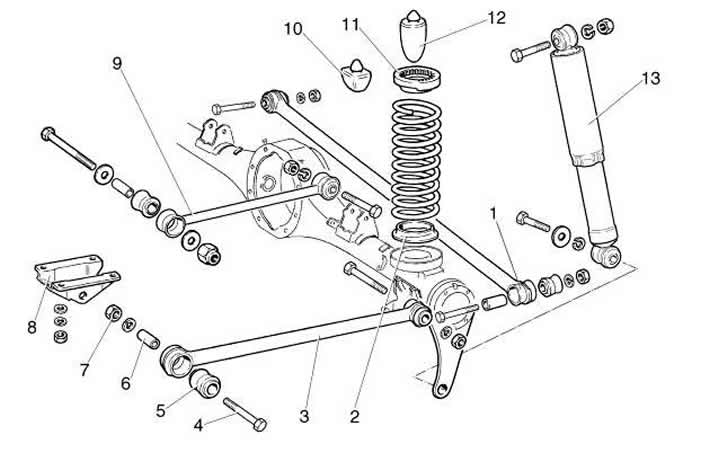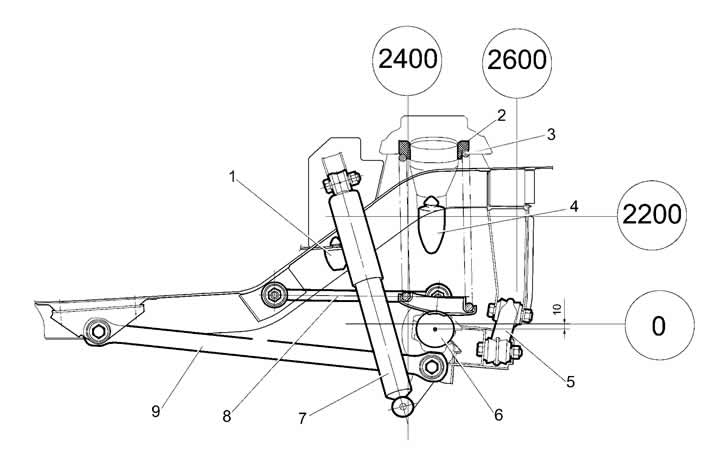Remove the rear wheel covers (in the presence of) and loosen the rear wheel nuts.
Place the shift lever in neutral position.
Hang the car, unscrew the rear wheel nuts and remove the rear wheels.
Disconnect the rear parking brake cable from the front cable.
Unscrew and remove the nuts with washers, remove the brackets for attaching the rear cable to the floor of the body.
Remove the front parking brake cable return spring.
Disconnect the locknut and adjusting nut of the front parking brake cable, remove the spacer and cable guide.
Disconnect the brake pipe from the brake hose, plug the brake pipe, remove the bracket and disconnect the brake hose from the body bracket.
Unscrew the nut of the bolt securing the rear brake pressure regulator lever strut to the axle beam, remove the bolt, disconnect the strut and remove the strut bushings from the rear axle bracket.
Unscrew the nuts of the bolts securing the driveshaft flange to the rear axle reduction gear flange and remove the bolts, disconnect the propeller shaft flange from the rear axle reduction gear flange.
Loosen the nuts of the shock absorber mounting bolts 13 (see fig. 4-12) to the rear axle beam.

Pic. 4-12. Rear Suspension Details:
1 - transverse rod;
2 - lower spring cup;
3 - lower longitudinal rod;
4 - bolt for fastening the lower rod;
5 - rubber bushing of the hinge;
6 - spacer sleeve;
7 - nut;
8 - bracket;
9 - upper longitudinal rod;
10 - additional compression stroke buffer;
11 - upper spring gasket;
12 - compression stroke buffer;
13 - rear shock absorber.
Place supports under the rear axle beam, lower the car until the shock absorbers are unloaded, remove the shock absorber mounting bolts.
Turn away nuts of bolts of fastening of cross 1 and longitudinal 3 bars of a back suspension bracket to a beam of the back bridge, take bolts, lift the car, take springs of a back suspension bracket and remove the back bridge in gathering. Do the work with two people.
Unscrew the tee fastening nut from the rear axle beam, disconnect the brake pipes from the brake cylinders and from the rear axle beam, install technological plugs on the tubes, remove the pipeline assembly with the flexible hose.
Installation of the rear suspension is carried out in the reverse order of removal, while the final tightening of the nuts of the shock absorber mounting bolts and the rear suspension rods is not performed.
Torque:
- wheel nuts - 85... 95 Nm (8.5...9.5 kgf·m).
Place the car on a lift, squeeze the rear suspension 2-3 times with the force of your hands, applying a load of 400... 500 N (6.5...7.5 kgf) to the rear bumper, finally tighten the nuts of the shock absorber mounting bolts and rear suspension rods.
Torque:
- nuts of bolts of fastening of shock-absorbers — 40... 60 Nm (4.0...6.0 kgf·m);
- nuts of bolts for fastening the transverse and longitudinal rods - 70... 80 Nm (7.0...8.0 kgf·m).
Check the oil level in the rear axle housing and top up if necessary. The oil level should be at the bottom edge of the filler hole.
Bleed the brake system, following the recommendations set out in subsection «Removal of air from the hydraulic actuator».
Adjust the parking brake following the recommendations set out in subsection «Parking brake adjustment».
Check the effectiveness of the rear brakes in accordance with the requirements of TI 3100.25100.13062.
At the same time, install springs of the same class on the suspension as on the front suspension. In exceptional cases, if the front suspension has springs of class «A», and there are no such springs for the rear suspension, it is allowed to install class springs «IN». If the front suspension has class springs «IN», then only class springs are installed in the rear suspension «IN».

Pic. 4-13. Rear suspension installation diagram:
1 - additional compression buffer;
2 - upper spring gasket;
3 - spring;
4 - compression stroke buffer;
5 - transverse rod;
6 - rear axle beam;
7 - rear shock absorber;
8 - upper longitudinal rod;
9 - lower longitudinal bar.
